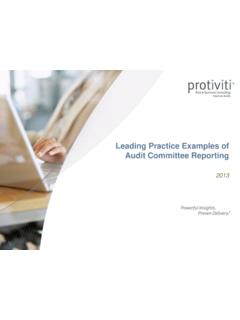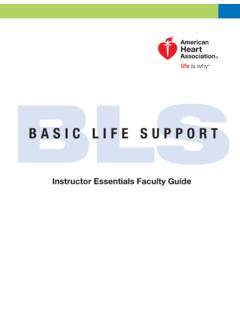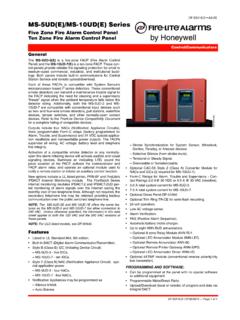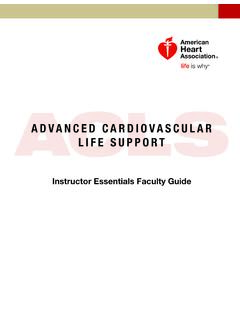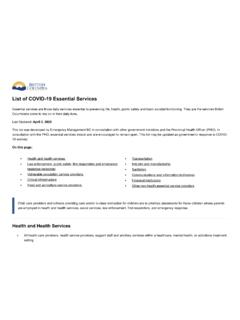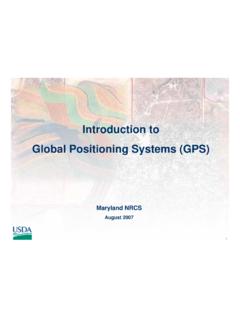Transcription of INTELLIGENCE COMMUNITY STANDARD NUMBER 705-1
1 INTELLIGENCE COMMUNITY STANDARD NUMBER 705-1 ICS 705-1 PHYSICAL AND TECHNICAL SECURITY STANDARDS FOR SENSITIVE COMPARTMENTED INFORMATION FACILITIES (EFFK'TlVE: 17 SEPTEMBER 2010) A. AUTHORITY: The National Security Act of 1947, as amended; Executive Order 12333, as amended; Executive Order 13526; INTELLIGENCE COMMUNITY Directive (leD) 705, Sensitive Compartmented Information Facilities; and other applicable provisions of law. B_ PURPOSE I. This INTELLIGENCE COMMUNITY STANDARD sets forth the physical and technical security standards that apply to all sensiti ve compartmented information facilities (SelF), including existing and new construction, and renovation of SerFs for reciprocal use by all INTELLIGENCE COMMUNITY (Ie) elements and to enalble information sharing to the greatest extent possible.
2 2. The standards contained herein facilitate the protection of sensitive compartmented infonnation (SCI), including protection against compromising emanations, inadvertent observation or overhearing, disclosure by unauthorized persons, forced entry, and the detection of surreptitious and covert entry. 3. The Assistant Deputy Director of National INTELLIGENCE for Security (ADDNlISEC) shall, in consultation with IC elements, develop and establi sh technical specifications to implement SClF standards that include descriptions of best practices. The ADDNIISEC shall, in consultation with Ie elements, review and update the Technical Specifications/or Construction and Management a/Sensitive Compartmented Information Facilities (hereinafter "Ie Tech Spec ") on an ongoing basis.
3 C. ApPLICABILITY 1. This STANDARD applies to the Ie, as defined by the National Security Act of 1947, as amended; and such other elements of any other department or agency as may be designated by the President, or designated jointly by the Director of National INTELLIGENCE and the head of the department of agency concerned, as an element of the Ie. ICS 705 \ 2. Ie elements shall fully implement this STANDARD within 180 days of its effective date. a. Facilities under construction or renovation as of the effective date of reD 705 shall be required to meet these standards or request a waiver to the standards.
4 B. SCIFs accredited as of the effective date ofICD 705 shall continue to be operated in accordance with the physical and teclmical security requirements applicable at the time of the most recent accreditation or re-accreditation. c. SerFs that have been de -accredited for less than one year but continuously controlled at least at the Secret level (in accordance with 32 CfR Parts 2001 and 2004) may be re-accredited one time, based upon the standards used for the previous accreditation. D . RECIPROCAL USE These standards are designed to ensure the protection of SCI and provide a secure environment for infonnation sharing and reciprocal use ofSCIFs.
5 Any SCIF that has been accredited by one IC element head or designee shall be reciprocally accepted by all IC elements when there are no waivers to these sumdards. Standards for reciprocal use are detailed in IC STANDARD 705-2, Standards for the Accreditation and Reciprocal Use of Sensitive Compartmented Information Facilities. A waiver may be necessary only in extraordinary ci rcumstances when these standards cannot be met. Waive:rs are detailed in section H of this STANDARD . E. RISK MANAGEMENT 1. Analytical risk management is the process of assessing threats against vulnerabilities and implementing security enhancements to achieve the protection of information and resources at an acceptable level of risk, and within acceptable cost.
6 The Accrediting Official (AD) must ensure the application of analytical risk management in the SelF planning, design and construction process. 2. Security in Depth a. Security in Depth (SID) is the acceptance of the AO of external and/or internal SelF factors that enhance the probability of detection before actual penetration to the SelF occurs by the existence of a layer or layers of s(xurity that offer mitigations for risks. b. To qualify for SID, at least one layer identified in the IC Tech Spec shall be applied. c . SID inside the United States will allow Cognizant Security Authorities (CSA) to use less stringent construction techniques, and increase the alarm response times.)
7 D. SID is mandatory for SClFs located outside the United States due to increased threat. F . SelF PLANNING AND DESIGN 1. selF security begins with the planning and design phase. To ensure security oversight is applied throughout development and accreditation, all SCIF planning shall begin with sponsorship by an AO. 2. Facility Types. Detennining where the SCIF will be located and how it will be used is necessary in determining what security enhancements may be necessary. Reciprocal use of the SClF shall be based upon the type of facility and its current use.
8 (For example, a facility 2 ICS 705-1 accredited for closed storage and non-amplified discussions is not reciprocal for open storage and amplified discussions.) a. Secure Work Area is an area accredited for use, handling, discussing, and/or processing of SCI but where SCI is not stored. h. Temporary Secure Working Area is a facility where the handling, discussing, and/or processing of SCI is limited to less than 40 hours per month but where SCI is not stored. c. Continuous Operation is a SelF that is staffed and operated 24 hours a day, seven days a week.
9 D . Temporary SelF is a facility determined to be necessary for a limited time to meet tactical, emergency, or immediate operational requirements. c. Open Storage accreditation allows SCI to be openly stored and processed within the SelF without using Govenunent Services Administration (GSA) approved storage containers. f. Closed Storage accreditation requires all SCI material to be stored in a GSA approved security container in an accredited facility 3. For each SCIF construction project, a Construction Security Plan (CSP) shall be developed to address the application of security to the SCrF planning, design, and construction efforts.
10 The specific format and content of the CSP may be developed by the AO based upon the extent of the SCIF construction and security concerns related to the SCIF. 4. Construction plans and all related documents shall be handled and protected in accordance with the CSP. rfclassification guides dictate, plans and related documents may require classification. Under no circumstances should plans, diagrams, etc. that are identified for a SCIF be sent or posted on unprotected information technology systems or Internet venue without encryption. 5. Construction and design ofSCIFs shall be performed by companies using persons (an individual who has been lawfully admitted for permanent residence as defined in 8 1101(a)(20) or who is a protected individual as defined by 8 1324b(a)(3)).










